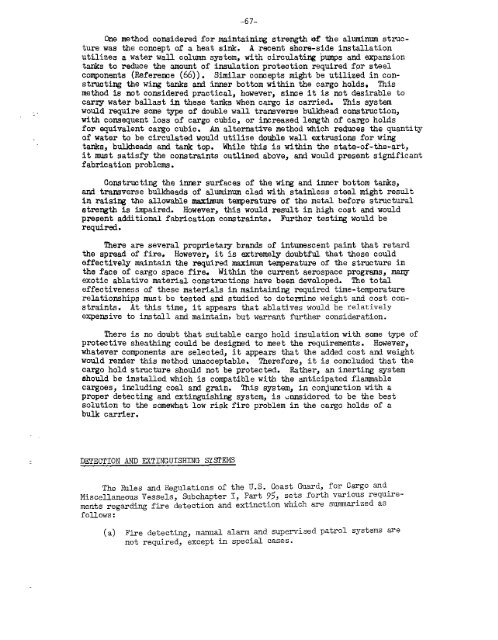design considerations for aluminum hull structures - Ship Structure ...
design considerations for aluminum hull structures - Ship Structure ...
design considerations for aluminum hull structures - Ship Structure ...
Create successful ePaper yourself
Turn your PDF publications into a flip-book with our unique Google optimized e-Paper software.
-67-One method considered <strong>for</strong> maintaining strength & the alumimun strutturewas the concept ot a heat sink. A recent shore-side instal.latimutilizes a water wall column system, with circulating pumps and expansiontanks to reduce tkm amount of insulation protection required fpr steeicolqponents(Refereme (66)). Similar cowepts might be utilifiedin corlstu.mtingthe wing tanks and innerbottom within the cargo holds. Thismethod is not considered practical, however, sime it is not desirable tocar~ water ballast in these tanks when cargo is carried. This systemwould require some type of double wall transverse bulkhead construction,with consequent lOSS of cargo chic, or imreased length of cargo holds<strong>for</strong> equivalent ca~o cubic. An alternative method which reduaes th~ quantityof water to be circulated would utilize double wall extrusions <strong>for</strong> wingtanka, bulkheads and tank top. While this is within the state-of-the-art,it must satisfy the constraints outlined above, and would present significantfabrication problems.Conetruoting the inner surfaces of the wing and inner bottom tanksjand tranwerse bulkheads of <strong>aluminum</strong> clad with stainless steal might resultin raising the adlowable msxhum temperature of the metal befpr~ structuraltstrengthis impaired. However, this would result in high cost and wouldpresent additional fabrication constraints. .Furthertesting would beraquired.There are several proprieta~ brands of intumescent paint that retardthe spread of fire. However, it is ~tremely doubtful that these couldeffectively maintain the reqtired ~imm temperature of the structure inthe face of cargo space fire. Within the current aerospace programs, manyexotic ablative material constructionshave been developed. The totaleffectiveness of these matefials in maintaining required the-temperaturerelationshipsmust be tested am studied b determine weight and cost constraints.At this time, it appears that ablatives would be relativelyexpensive to i~til and maintain, but w~rant ~rther consideration.There is no doubt that suitable cargo hold insulation with some type ofprotective sheathing could be <strong>design</strong>ed to meet the requiranents. However,whatever components are selected, it appea~ that the added cost ani weightwould retier this method unacceptable. There<strong>for</strong>e, it is concluded Mat thecargo hold structure should not be protected. Rather, an inerting systemshould be installed which is compatible with the anticipated flsmmablecargoes, including coal anl grain. This system, in conjumtion with aproper detecting and exti~ishing system, is tinmsideredto be the bestsolution to the somewhat low risk fire problem in the cargo holds of abulk carrier.DETECTION AND EXTINGUISHING SYSTEMSThe Fhles and Regulations of the U.S. Coast Guard, <strong>for</strong> Cargo andMiscellaneous Vessels, subchapter I, Part 955 sets fOrth various requtiementsregarding fire detection and extinction which are summarized asfollows:(a)Fire detecting, manual alarm and supervised patrol systems arenot required, except in special cases.
















